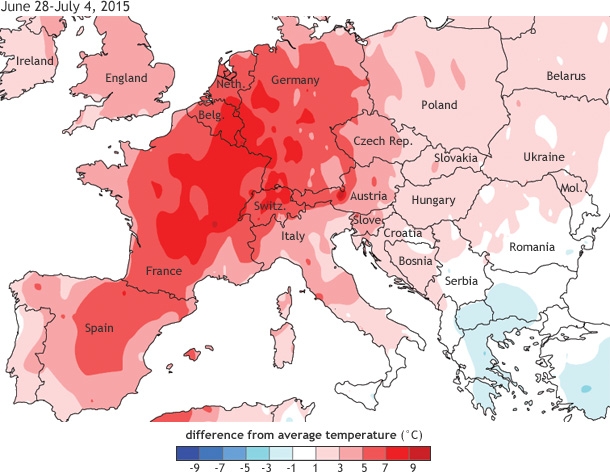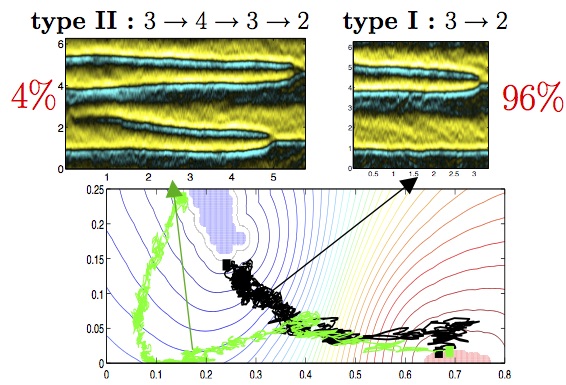CLIMATE DYNAMICS
a) Probability of extreme heat waves (project in collaboration with J. Wouters and F. Ragone, funded by AXA).
b) Probability of abrupt climate change : the example of Jupiter.
c) Is there a common principle behind the formation of ocean mesoscale eddies, ocean and atmosphere jets, or giant anticyclones as Jupiterís Great Red Spot?
Probability of extreme heat waves
What is the probability and dynamics of extreme heat
waves, for instance the heat wave over western Europe in
2003? Such events are very rare, but have a huge impact on
societies, economy and nature. Because those events are so
rare, we can not rely on empirical data from the past. Due
to the complexity of the turbulent atmosphere dynamics and
the low probability of observing these events, brute-force
numerical simulations are also of limited use. The
proposed project aims at the first use of techniques and
algorithms based on large deviation theory (from
statistical mechanics), designed specifically to determine
the rare probabilities and corresponding trajectories in
complex dynamical systems.

The 2015 heat wave over France (NOAA's Climate Prediction
Center).
While the present Earth climate has been extremely stable during the whole Holocene period, paleoclimate data show that the Earth has experienced drastic and abrupt climate changes in the past. Some of these abrupt climate changes, for instance transitions between glacial and interglacial periods, have probably been triggered by changes in the Earth orbital parameter (Milankovich cycles). However some others, for instance the Dansgaard-Oeschger, or the Heinrich events (see picture below) during the last glacial period are abrupt climate changes that have not been triggered by changes of external parameters.

Temperature in Greenland and the North Atlantic during
the last glacial period showing Dansgaard-Oeschger and
Heinrich abrupt temperature changes (picture from S.
Rahmstorf, Nature 2002, data from Grootes et al 1993 and
Sachs at al 1989)
Those
abrupt climate changes are examples of the climate system
internal variability. Such events are probably related to
the turbulent dynamics of the ocean and more precisely to
its overturning circulation. Predicting such transitions
in turbulent dynamics is a challenge as it requires to
have an extremely well resolved climate model, and at the
same time to run it on tens of millennial time scales. In
order to develop the numerical and theoretical tools to
address this challenge and to be able to study abrupt
climate changes in turbulent dynamics, we have addressed
the simplest problem of climate changes for Jupiterís
troposphere (see picture below).

Jupiter's troposphere jets and white oval anticyclones.
During the period 1939-1940
one of Jupiter's jet disappeared and led to the appearance
of white ovals (Rogers 1995). As Jupiter lost one of his
jets, Jupiter's climate abruptly changed (Markus 2005)
While this kind of jet instability can not be studied using direct numerical simulations of turbulent flows, because it appears so rarely, we can devise dedicated algorithms to predict the transition probability between different climates on Jupiter, using tools from statistical mechanics and large deviation theory. (see the point Large deviation theory for atmosphere jets below)

Transitions between attractors with 3, 4 and 2 jets in
a quasigeostrophic model of turbulent atmosphere in a
regime similar to Jupiter's troposphere one (Bouchet
Simonnet, see the seminar below)
This allows us to sample thousands of
transitions, and to compute transition rates and
transition paths between attractors. This new tools is
opening a large new field of research in climate science,
for a class of problems that involve rare events that are
impossible to study using conventional tools. (See
the point Large deviation
theory for atmosphere jets below)
Large
deviation theory for atmosphere jets:
Seminar given during the Workshop
on Instantons and Extreme Events in Turbulence
and Dynamical Systems, held at Rio de
Janeiro in December 2015 [movie] [slides]
See
also the computation
part of our research on large deviations and rare events.
Is their a common principle behind the self
organization of jets, cyclone, anticyclones, and ocean
currents in turbulent atmospheres and oceans
It
is striking to observe the strong analogies between the
emergence of cyclones, anticyclones, jets, and currents on
any turbulent flows dominated by the Coriolis force, such
as the Earth atmosphere, the Earth ocean, or Jovian planet
atmospheres. When these flows are in a inertial regime
(when the time scale for forcing and dissipation are much
larger that the time scale for the inertial turbulence),
one can actually explain the formation of these structures
using equilibrium statistical mechanics. They then appear
as maximum entropy states. This gives an amazing
explanation for the emergence of these structure and
predicts their detailed properties. These ideas have been
successfully applied to model the Great Red Spot of
Jupiter, ocean mesoscale vortices, and some of the ocean
currents. To
learn more about this approach.
F. BOUCHET, and A. VENAILLE, Statistical mechanics of two-dimensional and geophysical flows, Physics Reports, 2012 [.pdf]